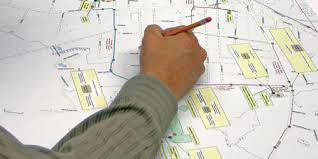The designer of the fiber network designs and digitizes fiber features using the standard G/Technology feature placement workflow and a fiber splicing editor. The end-to-end workflow is as follows. At a given location (central office, switching center), the user creates an ISP Connect feature. From this feature, the user places fiber cables, splices, remote terminals, service wires, and optical network units (ONUs) via the G/Technology new feature command. Each of these features is automatically connected via NodeOrdered Connectivity. During the design process, the designer has full access to all design information and uses a software tool that enforces standard design best practices. Both novice and experienced designers benefit from information access and the enforcement of recommended design best practices.
For example, designers can manually splice features, or automatically create them via functional interface so

ftware when the ends of two cables are in proximity. When created, the functional interface software attempts to perform a straight-through splice. If this is possible, the software completes the records for the splice and then sets the splice-type attribute to resolved. If a straight-through splice is not possible because of the presence of multiple cables, the software sets the splice-type attribute to unresolved.
These attributes allow the symbology of the splice to change to reflect its state and provide useful crosschecks during design.
The placement of fiber includes the cable network, splice closures, optical service wires, network termination devices at the home, splitters (in splices, cabinets, racks) and the central office terminating devices. The application also includes placement of the civil structures, such as conduit, manholes, poles, and housing structures (huts, buildings, and ECMs) to address all necessary infrastructure in one design.